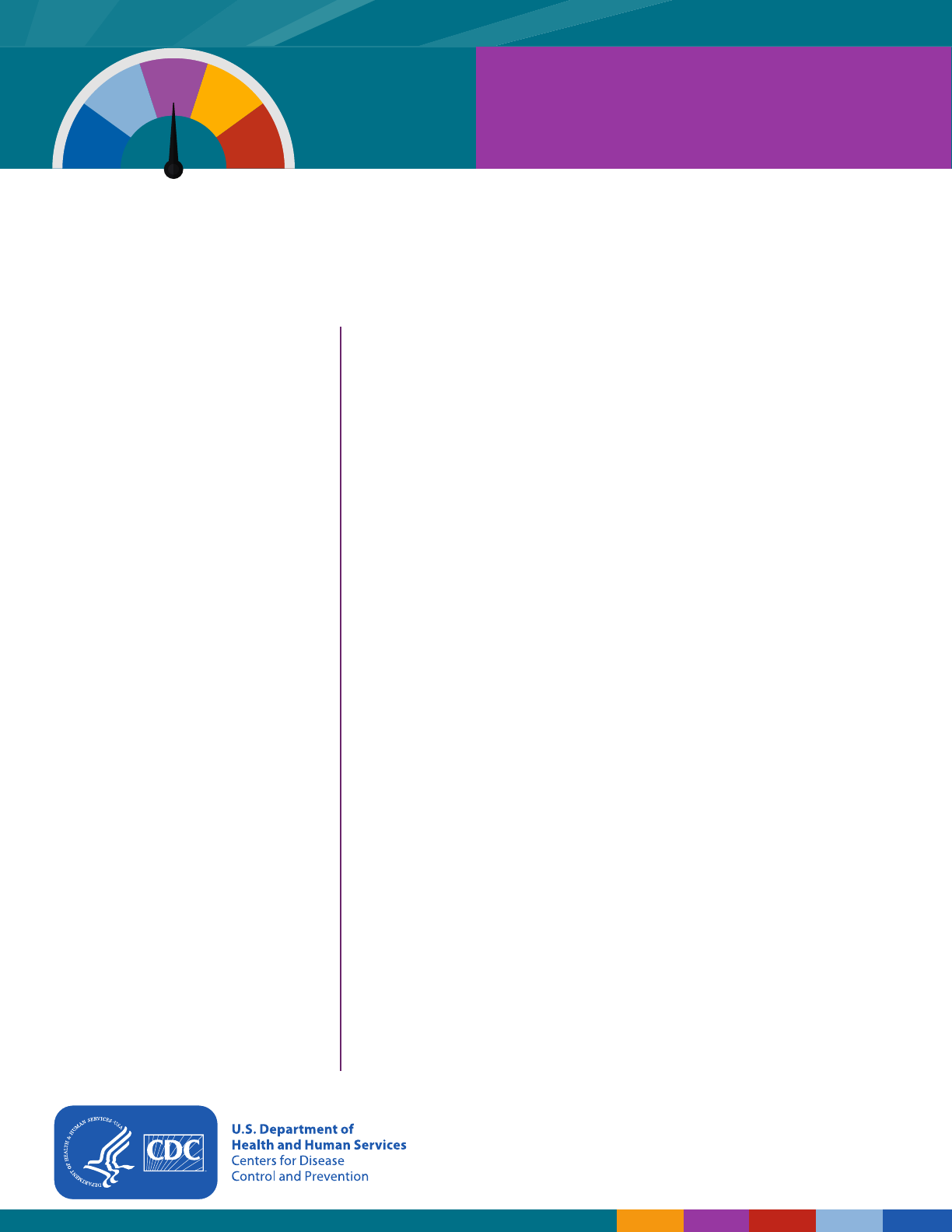
November 21, 2018C296013-C
Evaluation Briefs
Writing SMART Objectives
No. 3b | updated August 2018
This brief is about writing SMART objectives. This brief includes an overview of objectives, how to write SMART
objectives, a SMART objectives checklist, and examples of SMART objectives.
Overview of Objectives
For DASH funded programs, program
planning includes developing ve-year
program goals (a broad statement
of program purpose that describes
the expected long-term effects of a
program), strategies (the means or
broad approach by which a program
will achieve its goals), and annual
workplan objectives (statements
that describe program results to
be achieved and how they will be
achieved).
Objectives are more immediate than
goals; objectives represent annual
mileposts that your program needs
to achieve in order to accomplish
its goals by the end of the ve-year
funding period.
Each year, your workplan objectives
should be based on the strategies you
have selected to reach your program
goals. Because strategies are
implemented through objectives and
program activities, multiple objectives
are generally needed to address a
single strategy. Objectives are the
basis for monitoring implementation
of your strategies and progress
toward achieving your program goals.
Objectives also help set targets for
accountability and are a source for
program evaluation questions.
Writing SMART Objectives
To use an objective to monitor your progress, you need to write it as a SMART
objective. A SMART objective is:
1. Specific:
• Objectives should provide the “who” and “what” of program activities.
• Use only one action verb since objectives with more than one verb
imply that more than one activity or behavior is being measured.
• Avoid verbs that may have vague meanings to describe intended
outcomes (e.g., “understand” or “know”) since it may prove difcult to
measure them. Instead, use verbs that document action (e.g., “At the
end of the session, the students will list three concerns...”)
• Remember, the greater the specicity, the greater the measurability.
2. Measurable:
• The focus is on “how much” change is expected. Objectives should
quantify the amount of change expected. It is impossible to determine
whether objectives have been met unless they can be measured.
• The objective provides a reference point from which a change in the
target population can clearly be measured.
3. Achievable:
• Objectives should be attainable within a given time frame and with
available program resources.
4. Realistic:
• Objectives are most useful when they accurately address the scope of
the problem and programmatic steps that can be implemented within a
specic time frame.
• Objectives that do not directly relate to the program goal will not help
toward achieving the goal.
5. Time-phased:
• Objectives should provide a time frame indicating when the objective
will be measured or a time by which the objective will be met.
• Including a time frame in the objectives helps in planning and
evaluating the program.

Objectives Checklist
Criteria to assess objectives YES NO
1. Is the objective SMART?
• Specific: Who? (target population and persons doing the activity) and What? (action/activity)
• Measurable: How much change is expected
• Achievable: Can be realistically accomplished given current resources and constraints
• Realistic: Addresses the scope of the health program and proposes reasonable programmatic
steps
• Time-phased: Provides a timeline indicating when the objective will be met
2. Does it relate to a single result?
3. Is it clearly written?
SMART Objectives Examples
Non-SMART objective 1: Teachers will be trained on the
selected scientically based health education curriculum.
This objective is not SMART because it is not specic,
measurable, or time-phased. It can be made SMART by
specically indicating who is responsible for training the
teachers, how many will be trained, who they are, and by
when the trainings will be conducted.
SMART objective 1: By year two of the project, LEA staff
will have trained 75% of health education teachers in the
school district on the selected scientically based health
education curriculum.
Non-SMART objective 2: 90% of youth participants will
participate in lessons on assertive communication skills.
This objective is not SMART because it is not specic
or time-phased. It can be made SMART by specically
indicating who will do the activity, by when, and who will
participate in lessons on assertive communication skills.
SMART objective 2: By the end of the school year, district
health educators will have delivered lessons on assertive
communication skills to 90% of youth participants in the
middle school HIV- prevention curriculum.
For further information or assistance, contact the
Evaluation Research Team at [email protected]. You can
also contact us via our website: http://www.cdc.gov/
healthyyouth/evaluation/index.htm
